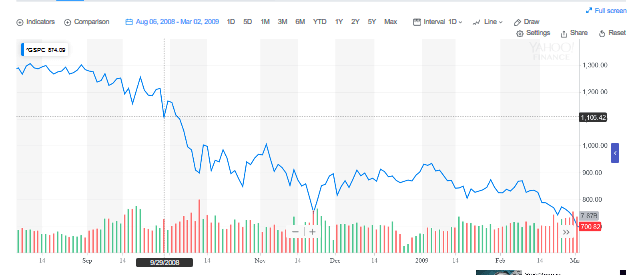By: Mark Glennon*
A March 2009 Bloomberg article told the story beautifully:
The Chicago Transit Authority retirement plan had a $1.5 billion hole in its stash of assets in 2007. At the height of a four-year bull market, it didn’t have enough cash on hand to pay its retirees through 2013, meaning it was underfunded to the tune of 62 percent.
Then the authority found an answer.
“We’ve identified the problem and a solution,” said CTA Chairman Carole Brown on April 16, 2007. The agency decided to raise money from a bond sale.
Carole Brown is now Chicago’s Chief Financial Officer and leading the charge for the city to issue a similar pension obligation bond for a whopping $10 billion. The concept is simple: Borrow money and invest it in the stock market.
The CTA bonds were sold and $1.1 billion was deposited into the CTA pension on August 6, 2008.
Yes, August 2008. Good times. Remember? The S&P 500 proceeded to drop 45% over the next eight months.

Mercifully, because the market had already destabilized when the bonds were sold, the CTA didn’t initially put the money in the stock market. Nor did the bond sale go as planned. The CTA ended up paying bondholders more than it expected — 6.8%. In other words, the whole plan went wrong and losses ensued, as Bloomberg explained in that 2009 article:
The proceeds of the bond sale, held in a money market fund, earned 2 percent — 70 percent less than what the fund was paying for the loan….
“There is negative arbitrage,” Brown says. “It’s better than having dumped the money into the equity market.”
The stock market did come roaring back after March 2009 — the beginning of a bull market that roughly quadrupled stock prices. Whether the CTA was able to capture those returns and salvage the pension bond proceeds isn’t entirely clear, but it appears that didn’t happen. The proceeds of the bond were commingled with other assets, the pension presumably got back into the market slowly after being in cash and many other factors have been at work.
But we know for sure that neither the pension bond nor the stock market run stabilized the pension. It deteriorated badly after receiving the bond proceeds, through the bull market. At the end of 2008, after it received the bond proceeds, the pension had an unfunded liability of $636 million and was 76% funded. Today, that unfunded liability is $1.6 billion and it is 53% funded.
So, the real lesson isn’t really about market timing, though CTA’s was clearly awful. Instead, it’s that you just don’t know how pension obligation bonds will turn out. In CTA’s case, Mr. Market obliterated both its hopes on the stock market and its interest cost on the bond. Nothing worked out as expected. Smaller market disruptions can do the same on a smaller scale.
Most importantly the CTA experience tells us how dishonest it is to be making the case for pension obligation bonds through a simple comparison of expected bond rates to hoped-for stock market returns. Brown has been making that case for Chicago’s proposed bonds quite brazenly: “We should do this because we can do it at 5.5 percent,’ then I just saved the city 2 percent. … It would change the unfunded liability and change how much more [in] future payments the city would have to make. We would be paying that debt at a rate of 5 or 6 percent versus 7.5 percent,” she says.
Ralph Martire of the public union supported Center for Tax and Budget Accountability made the same, deceitful case, pretending it’s a simple matter of comparing the interest rate on one credit card to another.
The truth probably is that the city’s real motivation for a pension obligation isn’t to get the two percent Brown claims. That would come to just $200 million per year, which would be nice, but wouldn’t really move the needle much on the pensions or on Chicago’s $8 billion budget. Instead, the bonds would be a huge gift from taxpayers to public unions, and Chicago is in the middle of a major round of new contracts negotiations with its unions.
More about Chicago’s likely real motivation’s are in out separate story linked here.
*Mark Glennon is founder and executive editor of Wirepoints.

 A set of state lawmakers want to extend CPS’ current school closing moratorium to February 1, 2027 – the same year CPS is set to transition to a fully-elected school board. That means schools like Manley High School, with capacity for more than 1,000 students but enrollment of just 78, can’t be closed for anther three years. The school spends $45,000 per student, but just 2.4% of students read at grade level.
A set of state lawmakers want to extend CPS’ current school closing moratorium to February 1, 2027 – the same year CPS is set to transition to a fully-elected school board. That means schools like Manley High School, with capacity for more than 1,000 students but enrollment of just 78, can’t be closed for anther three years. The school spends $45,000 per student, but just 2.4% of students read at grade level.
 Hopefully, all media will get the message, in Illinois, too.
Hopefully, all media will get the message, in Illinois, too. Ted joined Tom Miller of WJPF to talk about Illinois’ highest-in-the-nation property taxes, why lawmakers don’t want to touch the tax’s cost drivers, just how much Illinoisans’ tax burden has grown over the decades, why Gov. Pritzker failed to meet his promise to reform property taxes, and more.
Ted joined Tom Miller of WJPF to talk about Illinois’ highest-in-the-nation property taxes, why lawmakers don’t want to touch the tax’s cost drivers, just how much Illinoisans’ tax burden has grown over the decades, why Gov. Pritzker failed to meet his promise to reform property taxes, and more.
Whenever there is a stock market peak, Democrats propose retroactive pension increases (that cost nothing) and pension obligation bonds (that save money), and Republicans propose privatizing Social Security — because Wall Street needs a sucker to sell to at inflated stock prices.
Whenever the stock market is at a bottom, and such deals might stand a chance of being something other than a ripoff, all this stuff goes away.
Who and more importantly why would anyone buy the bonds, and who would insure them after Detroit,stockton,R.I.,Puerto Rico etc.
Unless the POB’s are used to SHORT the equity (and any other) markets, this is not going to turn out good.
the question has to be asked,are there any examples of pobs that have had positive outcomes anywhere anytime? if so, you would think the city and martieri would be touting them?
Sonoma County issued $210 million worth of POB’s in 2003 and $289 million in 2010. They were successful because they were sold after the dot-com plunge in 2002 and the great recession in 2008. So timing is everything. The only problem is that it did not fix the real problem, that the pension liability had grown by 700% since 1994 while government fund revenues grew 66%. The problem that needs to be solved is liability growth through pension reform and the bonds are issued to cover up the real problem that benefits are too rich. As proof, we pay 36%… Read more »
10 Billion Dollar corrupt scheme.
Chicago and CPS should have an emergency managers appointed, just like Detroit.
The plan is to borrow money and invest it, presumably in one lump sum, ten years into a bull market when the market is at all-time highs? What could go wrong?
Mark – Is the plan to continue making pension payments that include both the normal cost and the amortized debt on top of this bond issue? Or is the plan to have the POB cover the debt portion of the yearly pension payments going forward? Once the POB is issued, will they re-amortize the remaining pension debt?
Those are the big questions. Huge implications as you know. City hasn’t said.
Martire loves him some re-amortization, which would reduce the yearly pension payments, which would open up that money for operating expenses (which Martire also loves). This plan is jacked up if they don’t continue making the yearly pension payments (normal + debt) as they planned.
They are going to do anything they can with every trick the politicians let them get away with to cover their corrupt promises and keep power.
They will have to make their normal contribution which will not be changed by the issuance of the bonds. They will have lowered their unfunded liability payments but that savings will be replaced by the bond payments. .